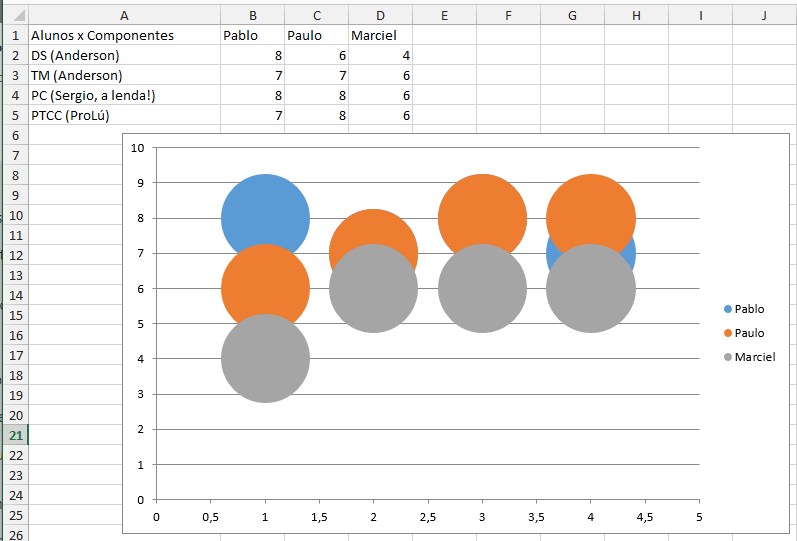Considere a seguinte interface

Utilize o seguinte código dentro do botão:
// Inicia o componente Excel
Excel.Application xlApp;
Excel.Workbook xlWorkBook;
Excel.Worksheet xlWorkSheet;
object misValue = System.Reflection.Missing.Value;
//Cria uma planilha temporária na memória do computador
xlApp = new Excel.Application();
xlWorkBook = xlApp.Workbooks.Add(misValue);
xlWorkSheet = (Excel.Worksheet)xlWorkBook.Worksheets.get_Item(1);
//incluindo dados
xlWorkSheet.Cells[1, 7] = "Dados do cliente:";
xlWorkSheet.Cells[2, 7] = textBox1.Text;
xlWorkSheet.Cells[3, 7] = textBox2.Text;
xlWorkSheet.Cells[4, 7] = textBox3.Text;
//Acrescentando mais dados, para gerar o gráfico.
xlWorkSheet.Cells[1, 1] = "Alunos x Componentes";
xlWorkSheet.Cells[1, 2] = "Pablo";
xlWorkSheet.Cells[1, 3] = "Paulo";
xlWorkSheet.Cells[1, 4] = "Marciel";
xlWorkSheet.Cells[2, 1] = "DS (Anderson)";
xlWorkSheet.Cells[2, 2] = "8";
xlWorkSheet.Cells[2, 3] = "6";
xlWorkSheet.Cells[2, 4] = "4";
xlWorkSheet.Cells[3, 1] = "TM (Anderson)";
xlWorkSheet.Cells[3, 2] = "7";
xlWorkSheet.Cells[3, 3] = "7";
xlWorkSheet.Cells[3, 4] = "6";
xlWorkSheet.Cells[4, 1] = "PC (Sergio, a lenda!)";
xlWorkSheet.Cells[4, 2] = "8";
xlWorkSheet.Cells[4, 3] = "8";
xlWorkSheet.Cells[4, 4] = "6";
xlWorkSheet.Cells[5, 1] = "PTCC (ProLú)";
xlWorkSheet.Cells[5, 2] = "7";
xlWorkSheet.Cells[5, 3] = "8";
xlWorkSheet.Cells[5, 4] = "6";
Excel.Range chartRange;
Excel.ChartObjects xlCharts = (Excel.ChartObjects)xlWorkSheet.ChartObjects(Type.Missing);
Excel.ChartObject myChart = (Excel.ChartObject)xlCharts.Add(100, 180, 500, 300);
Excel.Chart chartPage = myChart.Chart;
chartRange = xlWorkSheet.get_Range("A1", "d5");
chartPage.SetSourceData(chartRange, misValue);
chartPage.ChartType = Excel.XlChartType.xlBubble;
//Salva o arquivo de acordo com a documentação do Excel.
string caminho = Environment.GetFolderPath(Environment.SpecialFolder.MyDocuments);
File.Delete(caminho + "\\arquivo.xls");
xlWorkBook.SaveAs("arquivo.xls", Excel.XlFileFormat.xlWorkbookNormal);
xlWorkBook.Close(true, misValue, misValue);
xlApp.Quit();
//o arquivo foi salvo na pasta Documentos.
MessageBox.Show("Concluído. Verifique em " + caminho + "arquivo.xls");
//inicia a classe ProcessStartInfo
ProcessStartInfo AbrirArquivoExcel = new ProcessStartInfo();
//O caminho do arquivo do Excel
AbrirArquivoExcel.FileName = caminho + "\\arquivo.xls";
// executa o comando passado ao cmd
Process.Start(AbrirArquivoExcel);
Resultado:






